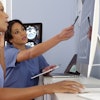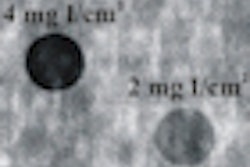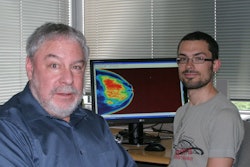Conebeam CT, breast MRI, and dual-energy mammography show promise as techniques to quantify breast density, which is linked to a higher risk of breast cancer, according to two new studies to be presented at this week's American Association of Physicists in Medicine (AAPM) annual meeting in Philadelphia.
Both studies were conducted by a group of medical physicists led by Sabee Molloi, PhD, at the University of California, Irvine. Graduate students Justin Ducote and Huy Le will present the results.
In the first study, the team found that dual-energy mammography holds promise for measuring breast density. The group used a dual-energy mammography system with a tungsten anode x-ray tube to image 20 pairs of postmortem breasts, taking low-energy (tube voltage of 28 kVp) and high-energy (tube voltage of 49 kVp) images. Half the tissue samples were rotated on their horizontal axis and half the samples were manually reconfigured to simulate craniocaudal and mediolateral oblique views.
"The results of postmortem studies indicated that dual-energy mammography is a repeatable measure of breast volume and breast density, and a reliable measure of breast mass," Ducote wrote.
In a related study, the group analyzed the ability of conebeam CT and breast MRI to measure breast density in 20 pairs of postmortem breasts. The conebeam CT system used a standard x-ray tube, a rotation stage, and a flat-panel detector. Each scan used a total of 147 mAs. MR images were acquired with an Aurora Imaging Technology 1.5-tesla dedicated breast MRI system.
This second study found that breast density measurements using conebeam CT and breast MR were highly correlated.
The next step, according to Molloi's team, is to quantify the exact density of the breasts in the study through chemical composition analysis. This is a destructive process, which is why the research was done using postmortem tissue.
By Kate Madden Yee
AuntMinnie.com staff writer
July 20, 2010
Related Reading
Researchers take a 3D approach to breast density, July 2, 2010
Screening mammography sensitivity is improving, study shows, May 27, 2010
Mammograms catch few cancers in young women: study, May 4, 2010
Conn. breast density law causes conundrum for mammo sites, April 29, 2010
Mātakina tackles breast density problem with Volpara software, February 3, 2010
Copyright © 2010 AuntMinnie.com




















